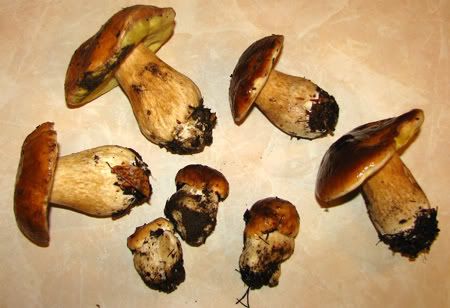Friday, 21 August 2009
A realistic look at the capital
Here is a nice little tourism video about the capital city. NB: you will only see the angel and the TVs on the walls if you drink loads of absinthe or take magic mushrooms. Also, nightclubs might not let you in with that hat.
Thursday, 20 August 2009
Grybauti Grybauti!
Grybauti - no its not the newest nickname for the country's newest President Dalia Grybauskaite - it is mushrooming!
Going mushrooming is as simple as the name would suggest - picking mushrooms, except you have to go into the forest to do it.

Grab a knife, a basket, some long pants and heavy duty socks (to protect against ticks, spiders and scratches) and you are ready to go.
Usually you will need a car and you will need to go deep into the forest to find a good spot that hasn't already been covered by others, but its nothing like Bear Grylls has to endure, but you will have to walk a good 20 metres from the car. People with poor orientation skills should not leave the sight of mushrooming companions lest they get lost in the forest.
It is of vital importance that you know what sort of mushrooms are edible - eating some species can make you sick or even kill you. You should go with a Lithuanian friend who knows which are good and which are not and even then you should consult a mushroom guide when you get home. Remember that "all mushrooms in the forest are edible, but some you can only eat once."
When you are picking mushrooms, check to see if it is still fresh and not rotten. You can do this by cutting the stem of the mushroom and looking for holes. If the mushroom is full of holes, it means it is rotten and you can just leave it.

When you get home, peel the tops of the mushroom off with a knife, wash the dirt off, boil them and they are ready for eating. Lithuanians do a number of things with them - eating them with sour cream and dill or just frying them up for a good old village feast.
Also, while out in the forest, keep an eye out for cowberries, which are in season at the moment!

Tuesday, 18 August 2009
An introduction to Vilnius

Writer and historian Laimonas Briedis has released his new book "Vilnius - City of Strangers." The book is a brief history of Vilnius, the capital of Lithuania, but unlike other history books it is fun to read and doesn't seek to impart a purely positive or nationalist view of the city on its readers.
The book is a collection of viewpoints of various writers who visited the city over the last half millennium since city founder Grand Duke Gediminas founded it in the 14th century. Various writings and analyses come from authors from the Vatican, Germany, Russia, Poland and more.
The book aims to show Vilnius today as it has been seen for the last 500 years - as a place of meeting and dispersal. It is a place of connections where people, trains, cultures, languages, and even armies have met.
The city is a gateway from east to west, in terms of both geography and culture. To the west is Europe as they knew it, and to the east is Russia.
Vilnius - City of Strangers is remarkably easy to read for a historical snapshot of one of Europe's richest cultural cities. Writings made over 500 years ago are still poignantly relevant to the lifestyle and habits of the city, whose personality hasn't changed dramatically, despite the changing of tenants uncountable times.
The city has been part of numerous empires throughout history, yet it always managed remain unchanged. Partly protected by the forests, swamps and rivers, only reachable in a bitter winter when the rivers were frozen, the city has always had its own spirit, a spirit that amazed and fascinated visitors.
Although not immediately clear from a Western point of view, it has been the city's contradictory tolerance and intolerance of itself and visitors that has allowed it to survive.
Visitors of today usually get drawn to the city by its seemingly impossible mix of cultures and languages that live in harmony. Vilnius has always been a polyglot city with languages like Polish, Armenian, Turkish, Ukrainian, Russian, German, Yiddish and more being spoken as main languages. Surprisingly, Lithuanian has rarely been the lingua franca of the city - in fact, under German occupation, signs were written in five languages to ensure complete understanding.
This multiculturalism has always been the situation in Vilnius with one exception - today the Jewish community is no longer an integral part of the city.
One of the book's strong points is the exploration of the Jewish culture of Vilnius. The Jewish population of the city once made up around 50 percent of the population - a significant portion compared to today's numbers where the Jews are a minority.
The Jewish population of Vilnius earned it the title of the 'Jerusalem of the North' by visiting rulers and brought prominent writers and thinkers to Vilnius to investigate what they described as the 'Ostjuden.'
Throughout the book are various illustrations that will surprise readers and shed light on the development of Lithuania's capital from being a smattering of hovels to the proud city that it is today.
Perhaps one of the downsides of the book is that it constantly fills in the background of the writers of the memoirs, which sometimes takes the reader far from Lithuania. While this is important to develop the background of the information, it often leaves readers wanting more direct information about the town.
Subscribe to:
Comments (Atom)
